Abstract
Vagal and carotid body paraganglia were obtained from 43 randomly selected autopsies performed at the National Naval Medical Center. In each case, tissue from both sides was step sectioned and comparatively studied. The mean combined weight of carotid bodies in 37 control patients was 25.9 mg. There was good correlation between size and number of separate paraganglia comprising the vagal body (seven left, six right). Lobules were closely related to the ganglion nodosum and were actually within it in three instances. Tissue resembling parathyroid was encountered within 4 of the 86 resected vagus nerves. Lymphocytic infiltration occurred in carotid and vagal body paraganglia of 28% and 16% of patients, respectively. There was Schwann cell proliferatation in carotid body lobules of 2 patients; in another patient, talc emboli were present. The mean combined weight of carotid bodies in 6 patients with chronic hypoxemia was 47.6 mg, significantly greater than in the control group; in each case, lobules were enlarged. Chief cell hyperplasia occurred in vagal body paraganglia of 2 patients; in two other patients, lobules were large with equal proliferation of constituent cells. These morphologic findings indicate that in patients with chronic hypoxemia some vagal body paraganglia can be ascribed a chemoreceptor role similar to but probably less important than that of the carotid body.
Full text
PDF



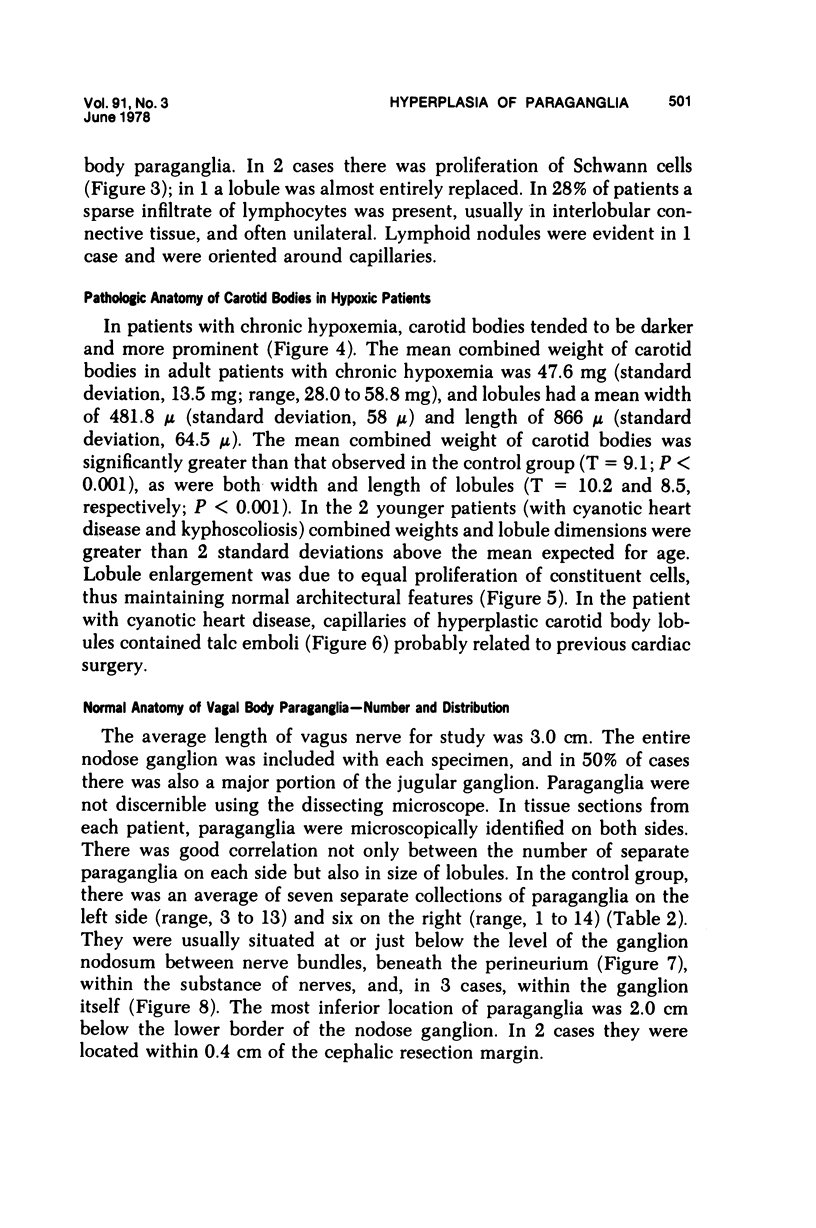
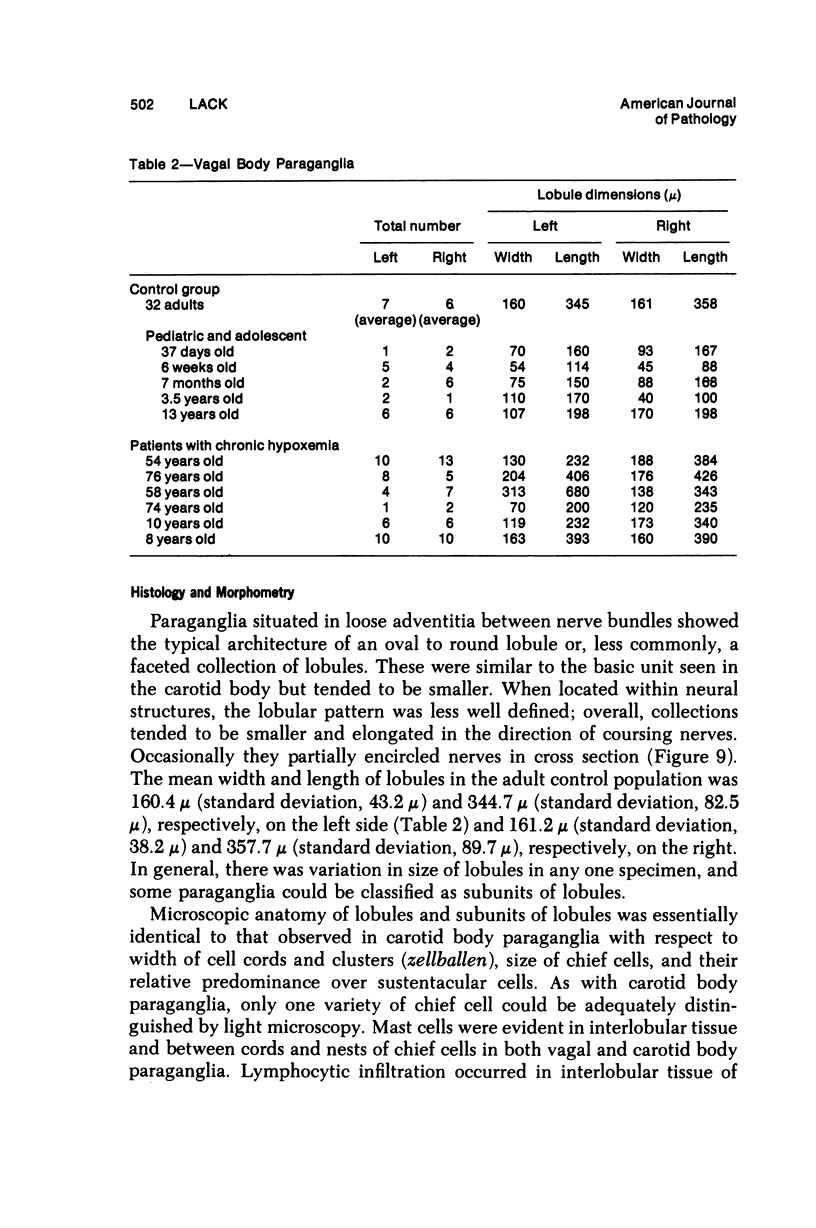


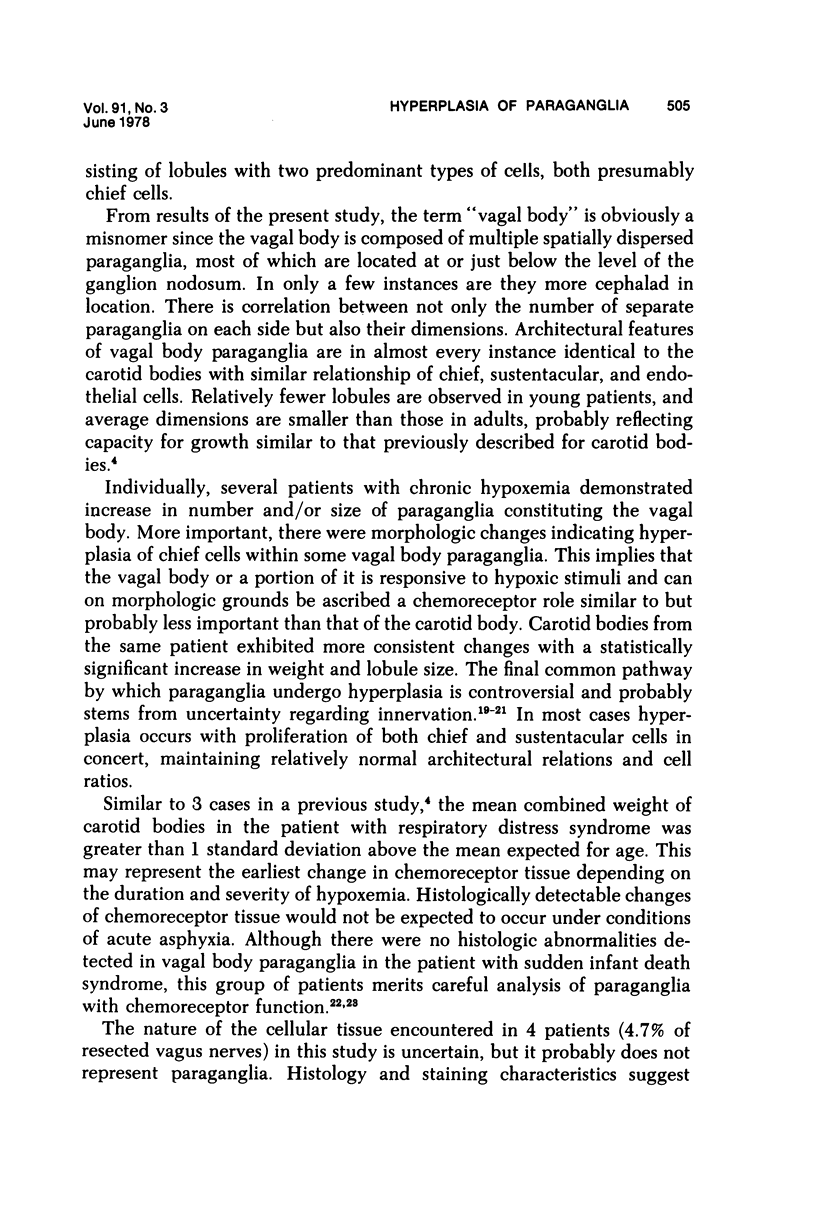



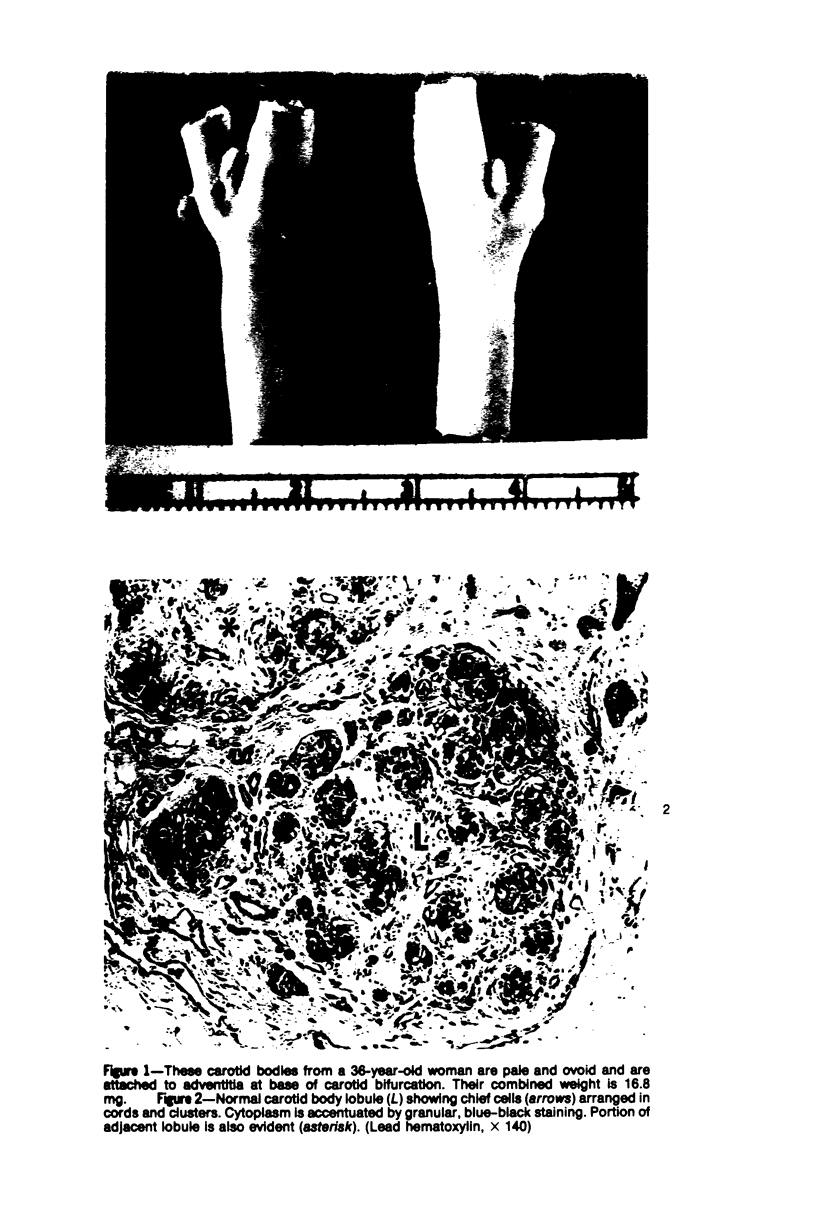

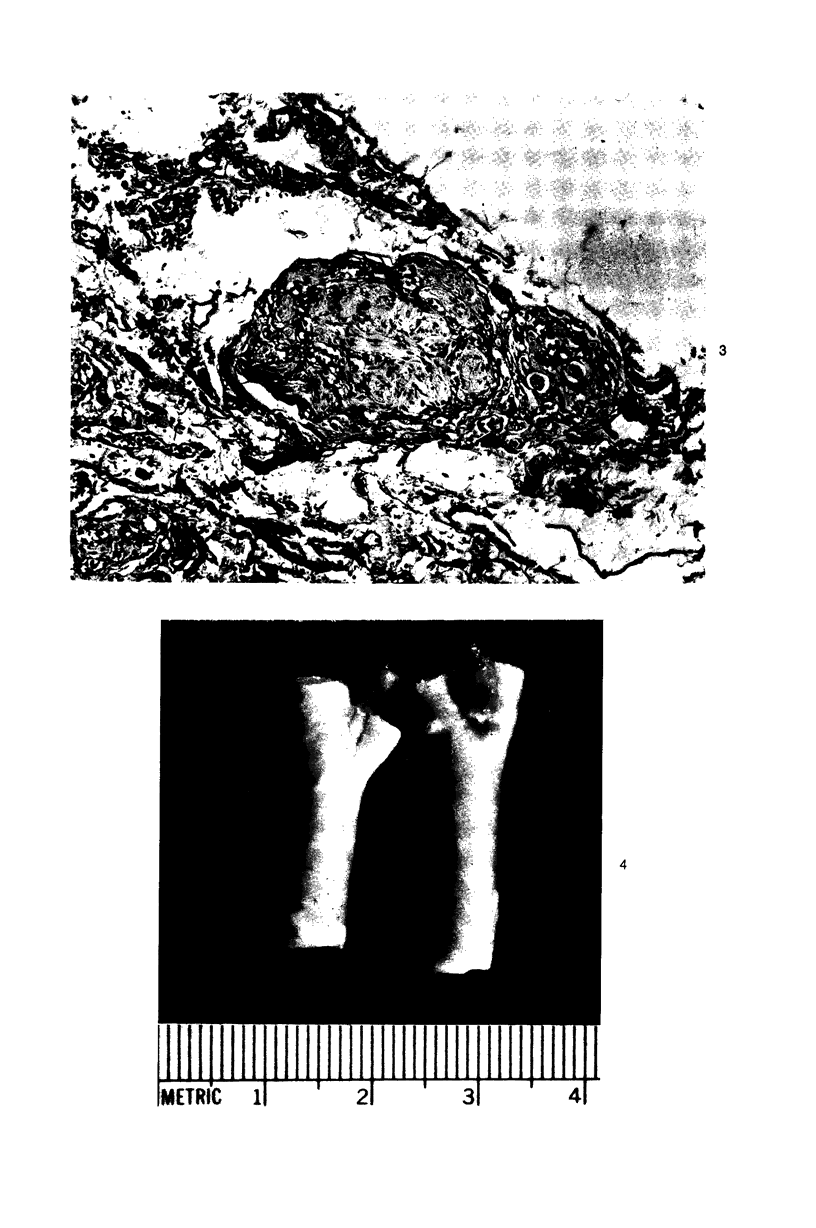





Images in this article
Selected References
These references are in PubMed. This may not be the complete list of references from this article.
- Arias-Stella J., Bustos F. Chronic hypoxia and chemodectomas in bovines at high altitudes. Arch Pathol Lab Med. 1976 Dec;100(12):636–639. [PubMed] [Google Scholar]
- Arias-Stella J., Valcarcel J. Chief cell hyperplasia in the human carotid body at high altitudes; physiologic and pathologic significance. Hum Pathol. 1976 Jul;7(4):361–373. doi: 10.1016/s0046-8177(76)80052-4. [DOI] [PubMed] [Google Scholar]
- BIRRELL J. H. The vagal body and its tumour. Aust N Z J Surg. 1953 Aug;23(1):48–54. doi: 10.1111/j.1445-2197.1953.tb05016.x. [DOI] [PubMed] [Google Scholar]
- Berger A. J., Mitchell R. A., Severinghaus J. W. Regulation of respiration (first of three parts). N Engl J Med. 1977 Jul 14;297(2):92–97. doi: 10.1056/NEJM197707142970206. [DOI] [PubMed] [Google Scholar]
- Budzilovich G. N. Granular cell "myoblastoma" of vagus nerve. Acta Neuropathol. 1968 Mar 4;10(2):162–165. doi: 10.1007/BF00691311. [DOI] [PubMed] [Google Scholar]
- Eyzaguirre C., Nishi K., Fidone S. Chemoreceptor synapses in the carotid body. Fed Proc. 1972 Sep-Oct;31(5):1385–1393. [PubMed] [Google Scholar]
- Gray S. W., Skandalakis J. E., Akin J. T., Jr Embryological considerations of thyroid surgery: developmental anatomy of the thyroid, parathyroids and the recurrent laryngeal nerve. Am Surg. 1976 Sep;42(9):621–628. [PubMed] [Google Scholar]
- Grimley P. M., Glenner G. G. Histology and ultrastructure of carotid body paragangliomas. Comparison with the normal gland. Cancer. 1967 Sep;20(9):1473–1488. doi: 10.1002/1097-0142(196709)20:9<1473::aid-cncr2820200914>3.0.co;2-i. [DOI] [PubMed] [Google Scholar]
- HEYMANS C. Action of drugs on carotid body and sinus. Pharmacol Rev. 1955 Mar;7(1):119–142. [PubMed] [Google Scholar]
- Heath D., Edwards C., Harris P. Post-mortem size and structure of the human carotid body. Thorax. 1970 Mar;25(2):129–140. doi: 10.1136/thx.25.2.129. [DOI] [PMC free article] [PubMed] [Google Scholar]
- JOELS N., NEIL E. The excitation mechanism of the carotid body. Br Med Bull. 1963 Jan;19:21–24. doi: 10.1093/oxfordjournals.bmb.a069999. [DOI] [PubMed] [Google Scholar]
- LATTES R. Nonchromaffin paraganglioma of ganglion nodosum, carotid body, and aortic-arch bodies. Cancer. 1950 Jul;3(4):667–694. doi: 10.1002/1097-0142(1950)3:4<667::aid-cncr2820030412>3.0.co;2-i. [DOI] [PubMed] [Google Scholar]
- Lack E. E. Carotid body hypertrophy in patients with cystic fibrosis and cyanotic congenital heart disease. Hum Pathol. 1977 Jan;8(1):39–51. doi: 10.1016/s0046-8177(77)80064-6. [DOI] [PubMed] [Google Scholar]
- Lack E. E., Cubilla A. L., Woodruff J. M., Farr H. W. Paragangliomas of the head and neck region: a clinical study of 69 patients. Cancer. 1977 Feb;39(2):397–409. doi: 10.1002/1097-0142(197702)39:2<397::aid-cncr2820390205>3.0.co;2-c. [DOI] [PubMed] [Google Scholar]
- Lange E., Johannessen J. V. Histochemical and ultrastructural studies of chemodectoma-like tumors in the cod (Gadus morrhua L.). Lab Invest. 1977 Jul;37(1):96–104. [PubMed] [Google Scholar]
- Naeye R. L. The sudden infant death syndrome: a review of recent advances. Arch Pathol Lab Med. 1977 Apr;101(4):165–167. [PubMed] [Google Scholar]
- Pearse A. G., Polak J. M., Rost F. W., Fontaine J., Le Lièvre C., Le Douarin N. Demonstration of the neural crest origin of type I (APUD) cells in the avian carotid body, using a cytochemical marker system. Histochemie. 1973;34(3):191–203. doi: 10.1007/BF00303435. [DOI] [PubMed] [Google Scholar]
- SETO H., YAMAMOTO S., FUJII T. On the paraganglia in the ganglion of the vagus nerve. Tohoku J Exp Med. 1950 May 31;52(1-2):39–42. doi: 10.1620/tjem.52.39. [DOI] [PubMed] [Google Scholar]
- Saldana M. J., Salem L. E., Travezan R. High altitude hypoxia and chemodectomas. Hum Pathol. 1973 Jun;4(2):251–263. doi: 10.1016/s0046-8177(73)80012-7. [DOI] [PubMed] [Google Scholar]
- Sampson S. R. Innervation of the carotid body: another point of view. Fed Proc. 1972 Sep-Oct;31(5):1383–1384. [PubMed] [Google Scholar]
- Solcia E., Capella C., Vassallo G. Lead-haematoxylin as a stain for endocrine cells. Significance of staining and comparison with other selective methods. Histochemie. 1969;20(2):116–126. doi: 10.1007/BF00268705. [DOI] [PubMed] [Google Scholar]
- Valdes-Dapena M. A. Editorial: Sudden, unexpected and unexplained death in infancy--a status report--1973. N Engl J Med. 1973 Nov 29;289(22):1195–1197. doi: 10.1056/NEJM197311292892213. [DOI] [PubMed] [Google Scholar]
















